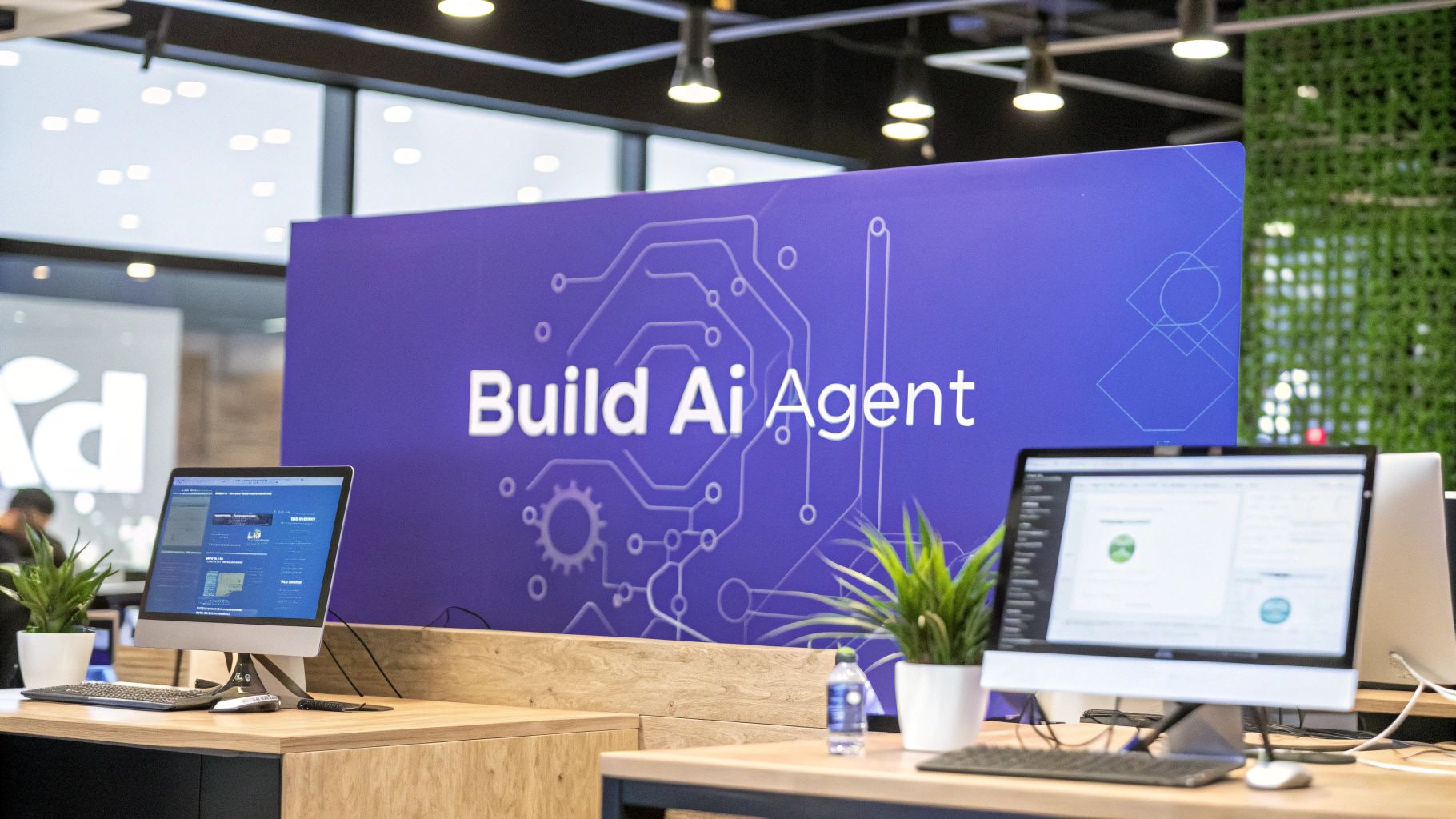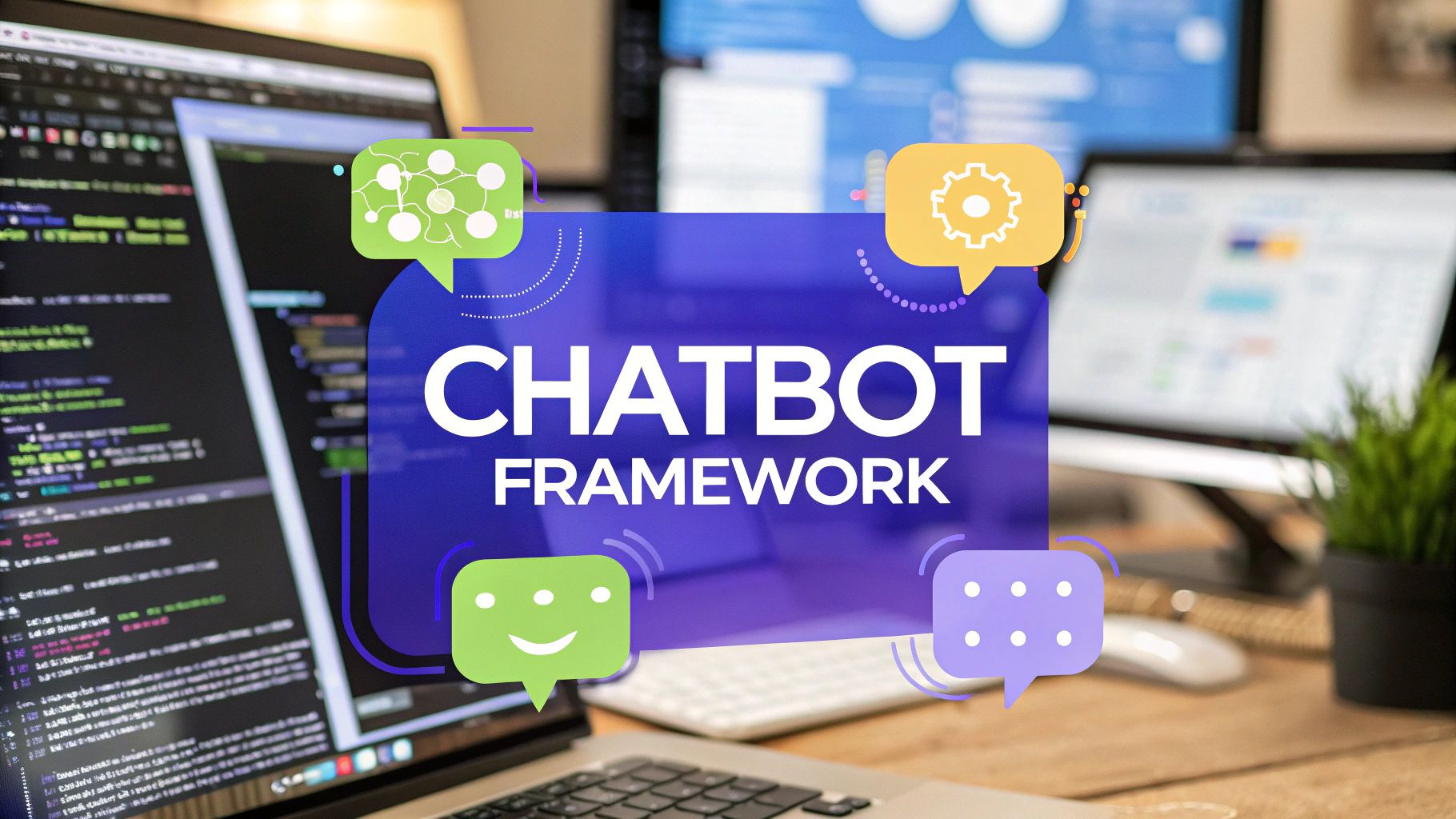Help Desk vs Service Desk A Guide for Your Business
Choosing between a help desk vs service desk? This guide breaks down the key differences with practical examples to help you pick the right IT support model.

When you hear someone talk about a help desk vs a service desk, it’s easy to think they’re the same thing. They’re not. The difference is actually pretty straightforward: a help desk is tactical and reactive, focused on fixing immediate problems like a password reset or a software bug. A service desk, however, is strategic and proactive, managing the entire lifecycle of IT services to support bigger business goals.
The Core Distinction Between IT Support Models
Confusing a help desk with a service desk is a common slip-up, but they play different roles in an IT strategy. Think of the help desk as your classic "break-fix" crew. Their main job is to resolve incidents and get people back to work as fast as possible. They are the frontline support for everyday technical snags.
A service desk operates on a much broader scale. It acts as a single point of contact for all IT-related requests, not just problems. This covers everything from ordering a new laptop and getting access to software, to reporting a system-wide outage. It’s designed to manage IT services in a way that aligns with what the business is trying to achieve. For a closer look at how information is organized to support these functions, check out our guide on knowledge base management systems.

This shift from a purely tactical function to a strategic one is a big deal, but the language people use often lags behind. In fact, research from Motadata shows that around 95% of end-users still call their IT support a ‘help desk’ even when their company has adopted a full-blown service desk model. It just goes to show how ingrained the old term is, even as the function itself evolves.
Quick Comparison Help Desk vs Service Desk
To make the distinction clear, here’s a high-level summary of the key differences. This table focuses on their primary function, scope, and strategic orientation, giving you a quick snapshot of where each model shines.
As you can see, a help desk is squarely focused on the user's immediate needs. A service desk takes a wider view, making sure IT operations directly contribute to the organization's success.
What Exactly Is a Help Desk?
When you think of IT support, you're probably picturing a help desk. It’s the tactical engine room of an IT team, acting as the first point of contact whenever an employee or customer hits a technical snag. Think of them as the ‘break-fix’ crew, focused on one thing: getting users back on track as fast as possible.
The core of their work revolves around incident management. This means they react to problems as they happen. A user can't log in, a printer won't connect, or an app keeps crashing. These are the classic tickets that fill a help desk queue. The goal is always rapid resolution to keep disruption and downtime to a minimum.

This reactive nature shapes the entire help desk model. They aren’t typically looking at the root cause of widespread issues or getting involved in long-term IT strategy. Instead, they concentrate on solving individual, isolated incidents one ticket at a time. The interaction is transactional: a problem comes in, a solution is delivered, and the ticket is closed.
How Help Desks Measure Success
Since the name of the game is speed and efficiency, help desks live and die by a very specific set of key performance indicators (KPIs). These metrics are all about how quickly and effectively the team can put out fires.
Common help desk KPIs include:
- First-Call Resolution (FCR): This is the percentage of issues solved during the very first interaction, without needing to escalate the ticket. A high FCR is the hallmark of a top-performing help desk.
- Average Ticket Closure Time: This tracks the clock from the moment a ticket is opened until it's fully resolved. A lower number here is always better.
- Ticket Volume: Keeping an eye on the number of incoming tickets helps with staffing and can signal a widespread problem if there's a sudden spike.
A well-run help desk is fundamentally user-centric. Its success isn't just about closing tickets; it's about restoring functionality for the end-user with minimal friction and delay.
The People Behind the Desk
Help desk agents need a specific blend of skills, primarily focused on troubleshooting and customer service. They’re the problem-solvers who can diagnose an issue on the fly and walk someone through the fix. But the high-pressure, fast-paced nature of this role brings some serious staffing challenges.
Employee turnover is a major operational hurdle. The average turnover rate in IT support roles hovers around 40%, which means companies are often replacing four out of every ten staff members each year. This churn directly impacts service quality and consistency, making strong management and support systems important. You can find more insights on the differences in support roles at Indeed.com.
Ultimately, a help desk serves a vital, tactical purpose. It keeps day-to-day operations humming by tackling the immediate tech roadblocks people face, making sure minor hiccups don’t snowball into major productivity losses.
How Does a Service Desk Work
Think of a service desk as the central nervous system for a company's IT operations. It takes a much broader, business-focused approach than a traditional help desk. It’s about delivering complete IT services that help the company move forward, not just fixing what's broken.
The service desk becomes the single point of contact for every IT-related need. This could be anything from an employee requesting a new laptop, needing access to a software suite, or reporting a system-wide outage. This entire approach is heavily influenced by the Information Technology Infrastructure Library (ITIL) framework, which brings a predictable, structured system to IT operations and makes sure they’re aligned with business goals.

Proactive IT Management
Instead of just reacting to problems as they pop up, a service desk works proactively to prevent them in the first place. This means managing the entire lifecycle of IT services to keep them reliable, efficient, and in line with what users actually need.
A few key functions make this happen:
- Service Request Management: This handles all the standard, pre-approved requests, like software installations or new hardware setups. It's the day-to-day stuff that keeps people productive.
- Problem Management: When the same incidents keep happening over and over, problem management digs in to find the root cause and fix it for good.
- Change Management: This process makes sure that any updates to IT systems from software patches to network upgrades are rolled out in a controlled way to minimize disruption.
The real goal of a service desk is to shift IT from a reactive "firefighting" department into a strategic business partner. It’s a move away from fixing individual tickets toward delivering consistent, high-quality services.
Aligning IT with Business Goals
A service desk is what bridges the gap between technical support and the company's bigger strategy. For instance, when a new employee is hired, the service desk doesn't just sit back and wait for a ticket. Instead, it kicks off a standard process to get the new hire all the hardware, software, and access they need to be productive from day one.
Today's service desks are leaning more and more on artificial intelligence to automate responses, predict issues, and improve self-service options. To see how this works in practice, you can explore resources on AI-powered service desk solutions. This automation is a game-changer for handling a wide range of requests efficiently. For more specific uses, learning how a chatbot for service desk operations can streamline user interactions is a great next step.
This move to automation has seriously changed the economics of IT support. Organizations using features like workflow engines and auto-assignments often see resolution times drop by 30-50%. These are not just cost savings; they free up IT staff to focus on more strategic work that drives the business forward.
Breaking Down the Core Differences
While it’s common to hear "help desk" and "service desk" used interchangeably, they operate on fundamentally different philosophies. One is built for speed and tactical fixes; the other is designed for strategic alignment and delivering IT as a service.
Looking beyond the surface-level definitions, their day-to-day functions reveal a major split in scope, purpose, and how they measure success. This is not just about semantics. It shapes how IT partners with the rest of the business. Understanding these differences is key to choosing the right model for your organization's needs.
Let’s dig into how they really stack up.
Tactical Break-Fix vs Strategic Service Delivery
The clearest distinction comes down to their core mission. A help desk is all about tactical, reactive support. Its job is incident management, which is a straightforward way of saying it fixes things that are already broken.
Think of it this way: an employee’s laptop can’t connect to the Wi-Fi. They call the help desk, and the agent’s only goal is to solve that one problem as fast as possible. This is the classic “break-fix” model, and its value is measured in speed.
A service desk, on the other hand, takes a strategic, proactive approach. It is not just there to fix problems but to deliver a full suite of IT services that support broader business goals. It acts as a single, organized entry point for all IT-related needs, from broken hardware to new software requests.
For example, an employee who needs a new software license would go through the service desk. The request is managed, approvals are handled, and the installation is coordinated, all as a standard, repeatable service offering.
Incident Management vs Holistic Service Management
The scope of their work is another massive differentiator. Help desks are laser-focused on incident management. They are experts at troubleshooting and resolving individual technical issues that stop someone from doing their job.
A help desk’s success is all about speed and efficiency. Metrics like First Call Resolution (FCR) and Average Ticket Closure Time are king because the main objective is to get users back to work with minimal downtime.
A service desk, however, practices holistic service management, often guided by frameworks like ITIL (Information Technology Infrastructure Library). It handles a much wider range of activities that go far beyond just fixing what’s broken.
This includes:
- Incident Management: Just like a help desk, it resolves unexpected issues.
- Problem Management: It takes things a step further by analyzing why incidents keep happening. If dozens of users report the same software bug, the service desk works to find and fix the root cause for good.
- Change Management: It oversees system updates and changes in a structured way to make sure they don’t cause new problems.
- Service Request Fulfillment: It manages all standard, repeatable requests like getting new hardware, requesting software access, or resetting a password through a defined and predictable process.
This broader scope means a service desk isn’t just putting out fires; it’s actively building a more stable and reliable IT environment.
Measuring Success Differently
How each team defines a “job well done” really tells you everything you need to know. For a help desk, success is almost entirely quantitative and user-focused. The metrics are direct and reflect its tactical mission of closing tickets quickly.
A service desk’s success metrics are far more qualitative and business-focused. While it still tracks things like resolution times, its real value is judged by its contribution to business outcomes. It measures things like user satisfaction, the overall business impact of IT services, and its ability to meet service level agreements (SLAs) that are tied directly to business objectives.
To make this crystal clear, here’s a side-by-side breakdown of their core operational differences.
Help Desk vs Service Desk Feature Breakdown
This table provides a quick reference for comparing the two models across key operational criteria.
The choice is not about which one is "better." It's about which model truly aligns with your organization's current IT maturity, complexity, and strategic goals. A help desk provides a needed tactical function, while a service desk offers a much more integrated and strategic partnership with the business.
When to Choose a Help Desk vs. a Service Desk
Deciding between a help desk and a service desk is not about picking the "better" option. It's about finding the right fit for your company’s size, complexity, and where you're headed. The best choice is the one that solves the problems you actually have today.
To make this clearer, let's walk through a few real-world business scenarios. These examples show how different company needs naturally lead to one model over the other.
Scenarios Where a Help Desk Is the Right Fit
A traditional help desk shines in environments where the name of the game is rapid, tactical problem-solving. It's an efficient model for companies that need to keep things simple and get users back to work as quickly as possible.
1. Small Businesses and Startups
A small company with 15-50 employees usually has pretty straightforward IT needs. The priority is keeping everyone online and productive, period. In this setting, a help desk is the perfect solution.
For example, a marketing agency with 30 employees doesn't need a complicated system to manage IT changes. They just need a reliable person to call when a software glitch pops up, a computer is running slow, or a password needs to be reset. A help desk provides that direct, break-fix support without the overhead of a full service management framework.
2. Companies with a Single, Focused Product
Imagine a software company that sells one specific application to its customers. Their support team’s main job is to handle user questions and bug reports related to that single product.
A help desk is ideal here. Its incident-focused structure is perfect for logging, tracking, and resolving customer-reported issues efficiently. The goal is to fix the immediate problem for the customer, not to manage the company's internal IT services.
For organizations where IT support is all about fixing immediate, user-facing problems, a help desk delivers the necessary speed and focus. It’s a direct solution for a direct need.
When a Service Desk Becomes Necessary
As a company grows, its IT support needs change. The focus naturally shifts from just fixing problems to strategically managing all the IT services that keep the business running. This is where a service desk becomes the clear choice.
1. Mid-Sized to Large Enterprises
Once you have several hundred or thousands of employees spread across multiple departments, the IT environment gets a lot more complicated. A service desk is built to handle this kind of scale.
Think about a large financial firm. Employees need access to dozens of different software systems, each with specific permissions. New hires need a standard set of hardware and software, and when someone leaves, their access has to be revoked securely and immediately.
A service desk manages all of this through repeatable, documented processes. It handles service requests (like ordering a new laptop), keeps track of IT assets, and oversees system changes in a controlled way. This strategic approach is important for maintaining security and compliance in a larger organization.
2. Companies with Strict IT Governance and Compliance Needs
Businesses in regulated industries like healthcare or finance have to follow strict rules for IT management. They need to document every single change, track all IT assets, and prove they have secure processes in place for auditors.
A service desk, often guided by ITIL principles, provides the structure needed for this. For instance, if a hospital needs to update its patient record software, it can't just be rolled out overnight. A service desk would manage this through a formal change management process, making sure the update is tested, approved, and documented to meet all compliance standards.
Ultimately, the choice in the help desk vs service desk debate comes down to your operational reality. A help desk is perfect for tactical, reactive support, while a service desk is built for strategic, proactive service delivery in more complex environments.
How to Select the Right Model for Your Company
Picking between a help desk and a service desk really comes down to what your company needs right now and where you see it going. There's no single "best" choice. It’s about finding the model that fits your company's size, IT maturity, and overall business strategy.
To get started, ask your team a few direct questions. Are you mainly trying to put out fires and fix immediate problems? Or are you looking to build and improve business-wide processes? Your answer here is a massive clue. If your focus is on quick, tactical fixes for user issues, a help desk is probably your best bet.
But if your goals are more strategic, a service desk is likely the way to go. Think about whether you need to manage IT changes systematically or offer a single, organized place for all IT-related requests, not just break-fix tickets. This is a huge differentiator.
Evaluate Your Current and Future Needs
The size of your company is a major factor. A small business with straightforward IT can get by just fine with a responsive help desk. As you grow, though, so does your complexity. Managing IT assets, user access, and system changes across different departments demands a more structured approach. That's where a service desk shines.
This decision tree offers a simple way to visualize which model might be right for your organization, based on what you're trying to accomplish.

As you can see, companies focused on quick fixes for smaller teams are better suited for a help desk. Those with complex IT needs tied directly to business goals should lean toward a service desk.
Making the Final Decision
Of course, budget is always a practical consideration. Help desks are generally less expensive to set up and run because their scope is much narrower. Service desks require a bigger investment in both technology and people, thanks to their broader, more strategic functions.
Talk these final points over with your team:
- Business Objectives: Do you just need IT to keep daily operations running, or does it need to be a strategic partner in hitting long-term company goals?
- IT Maturity: Is your IT department currently stuck in reactive troubleshooting mode, or is it ready for proactive processes like problem and change management?
- User Experience: Are you trying to provide a quick fix for issues, or do you want to offer a complete service experience for every IT-related need?
The most important question is how IT can best support your business. A help desk keeps the lights on, while a service desk helps plan the building's expansion.
For organizations trying to figure this out, an external IT consultation service can offer valuable insights. If you're leaning toward a specific tool, our detailed help desk software comparison can also bring some clarity.
Ultimately, whether you choose a help desk, a service desk, or even a hybrid model, the goal is to land on a solution that grows with you.
Frequently Asked Questions
When you're weighing a help desk vs. a service desk, a few common questions always seem to pop up. Getting these sorted can make it much clearer which path is right for your business. Let's tackle a few of them.
Can a Help Desk Become a Service Desk?
Absolutely. In fact, it’s a natural evolution for many growing companies. This isn't just a simple name change. It’s a complete shift in mindset and strategy.
Moving from a help desk to a service desk means going from a purely reactive, break-fix model to a proactive, service-first approach. You’ll start integrating ITIL-aligned practices like problem, change, and service request management. The goal is no longer just about closing tickets fast; it's about delivering IT services that actively push business goals forward.
Are the Tools for Help Desks and Service Desks Different?
They can be, though they often share a foundation. While both rely on ticketing systems, the software suites built around them are usually designed for different levels of complexity. Help desk software is typically laser-focused on efficient incident management, which means logging, tracking, and resolving user issues as quickly as possible.
Service desk software, on the other hand, is much more comprehensive. It does everything a help desk tool does but adds powerful modules for things like:
- IT Asset Management: Keeping track of all company hardware and software.
- Problem Management: Digging in to find and fix the root cause of recurring incidents.
- Change Management: Rolling out system updates in a structured, predictable way.
- Service Catalog: Giving users a clear menu of available IT services they can request.
Is a Service Desk Always Better?
Not at all. The "better" choice really comes down to a company’s size, complexity, and what it’s trying to achieve. A service desk isn’t inherently superior; it’s just built for a different purpose.
A startup with straightforward IT needs would likely find a help desk more cost-effective and perfectly capable of handling its workload. On the other hand, a large, complex organization with strict compliance rules will see a service desk as necessary for keeping its IT ecosystem running smoothly. The right choice is the one that fits your operational reality right now and aligns with where you're headed.
Ready to streamline your support with an intelligent assistant? Chatiant lets you build custom AI agents trained on your data to handle help desk queries, automate tasks, and integrate seamlessly with Google Chat or your website. Get started with Chatiant today


